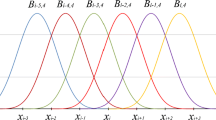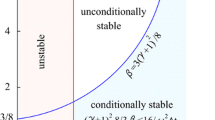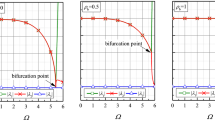Abstract
In this study, a novel hybrid sub-step explicit time integration method based on cubic B-spline interpolation and integration procedure is proposed. In the procedure, a “momentum corrector” technique of load integration is employed to achieve improved solution accuracy for both linear and nonlinear dynamic problems. New method has three free parameters, and can flexibly control basic algorithm properties including accuracy, stability and numerical dissipation. With optimized algorithmic parameters, new method can achieve at least second-order accuracy with or without physical damping, and achieve third-order accuracy without physical damping. Numerical examples demonstrate, compared with other competitive explicit methods, new method shows far higher solution accuracy for general linear dynamic problems, discontinuous applied load, wave propagation problem and nonlinear dynamic problems.



























Similar content being viewed by others
References
Bathe, K.J.: Finite Element Procedures (2nd Edition) Prentice-Hall, (2014)
Humar, J.: Dynamics of Structures: Second Edition Crc Press, (2002)
Giorgio, I., Del Vescovo, D.: Energy-based trajectory tracking and vibration control for multilink highly flexible manipulators. Math. Mech. Compl. Syst. 7, 159–174 (2019). https://doi.org/10.2140/memocs.2019.7.159
Turco, E., Barchiesi, E., dell’Isola, F.: A numerical investigation on impulse-induced nonlinear longitudinal waves in pantographic beams. Math. Mech. Solids 27, 22–48 (2022). https://doi.org/10.1177/10812865211010877
Subbaraj, K., Dokainish, M.A.: A survey of direct time-integration methods in computational structural dynamics—II. Implicit methods. Comput. Struct. 32, 1387–1401 (1989). https://doi.org/10.1016/0045-7949(89)90315-5
Wen, W.B., Wei, K., Lei, H.S., Duan, S.Y., Fang, D.N.: A novel sub-step composite implicit time integration scheme for structural dynamics. Comput Struct 182, 176–186 (2017). https://doi.org/10.1016/j.compstruc.2016.11.018
Zhang, H., Zhang, R., Masarati, P.: Improved second-order unconditionally stable schemes of linear multi-step and equivalent single-step integration methods. Comput. Mech. 67, 289–313 (2021). https://doi.org/10.1007/s00466-020-01933-y
Dokainish, M.A., Subbaraj, K.: A survey of direct time-integration methods in computational structural dynamics—I. Explicit methods. Comput. Struct. 32, 1371–1386 (1989). https://doi.org/10.1016/0045-7949(89)90314-3
Har, J., Tamma, K.K.: Thirteen. Time Discretization of Equations of Motion: Overview and Conventional Practices, Wiley, Ltd, (2012)
Tseng, J.C., Hwu, J.G.: Fourteen. Time Discretization of Equations of Motion: Recent Advances, Wiley (2012)
Gebhardt, C.G., Romero, I., Rolfes, R.: A new conservative/dissipative time integration scheme for nonlinear mechanical systems. Comput. Mech. 65, 405–427 (2020). https://doi.org/10.1007/s00466-019-01775-3
Chung, J., Lee, J.M.: A new family of explicit time integration methods for linear and non-linear structural dynamics. Int. J. Numer. Meth. Eng. 37, 3961–3976 (1994). https://doi.org/10.1002/nme.1620372303
Zhai, W.M.: Two simple fast integration methods for large-scale dynamic problems in engineering. Int. J. Numer. Meth. Eng. 39, 4199–4214 (1996). https://doi.org/10.1002/(SICI)1097-0207(19961230)39:24%3c4199::AID-NME39%3e3.0.CO;2-Y
Hulbert, G.M., Chung, J.: Explicit time integration algorithms for structural dynamics with optimal numerical dissipation. Comput. Methods Appl. Mech. Eng. 137, 175–188 (1996). https://doi.org/10.1016/S0045-7825(96)01036-5
Tchamwa, B., Conway, T. and Wielgosz, C.: Accurate explicit direct time integration method for computational structural dynamics Recent Advances in Solids and Structures - 1999 (The ASME International Mechanical Engineering Congress and Exposition) ASME, Fairfield, NJ, United States, pp 77–84, (1999)
Wen, W.B., Duan, S.Y., Yan, J., Ma, Y.B., Wei, K., Fang, D.N.: A quartic B-spline based explicit time integration scheme for structural dynamics with controllable numerical dissipation. Comput. Mech. 59, 403–418 (2017). https://doi.org/10.1007/s00466-016-1352-5
Soares, D., Jr.: A novel time-marching formulation for wave propagation analysis: The adaptive hybrid explicit method. Comput. Methods Appl. Mech. Eng. (2020). https://doi.org/10.1016/j.cma.2020.113095
Noh, G., Bathe, K.-J.: An explicit time integration scheme for the analysis of wave propagations. Comput. Struct. 129, 178–193 (2013). https://doi.org/10.1016/j.compstruc.2013.06.007
Kim, W., Reddy, J.N.: Novel explicit time integration schemes for efficient transient analyses of structural problems. Int. J. Mech. Sci. 172, 105429 (2020). https://doi.org/10.1016/j.ijmecsci.2020.105429
Li, J., Yu, K.: Development of composite sub-step explicit dissipative algorithms with truly self-starting property. Nonlinear Dyn 103, 1911–1936 (2021). https://doi.org/10.1007/s11071-021-06202-y
Zhang, H., Zhang, R., Zanoni, A., Xing, Y., Masarati, P.: A novel explicit three-sub-step time integration method for wave propagation problems. Arch. Appl. Mech. (2022). https://doi.org/10.1007/s00419-021-02075-0
Wen, W., Deng, S., Duan, S., Fang, D.: A high-order accurate explicit time integration method based on cubic b-spline interpolation and weighted residual technique for structural dynamics. Int. J. Numer. Meth. Eng. 122, 431–454 (2021). https://doi.org/10.1002/nme.6543
Zhang, J., Liu, Y., Liu, D.: Accuracy of a composite implicit time integration scheme for structural dynamics. Int. J. Numer. Meth. Eng. 109, 368–406 (2017). https://doi.org/10.1002/nme.5291
Zhang, J.: A-stable two-step time integration methods with controllable numerical dissipation for structural dynamics. Int. J. Numer. Meth. Eng. 121, 54–92 (2020). https://doi.org/10.1002/nme.6188
Hilber, H.M., Hughes, T.J.R.: Collocation, dissipation and [overshoot] for time integration schemes in structural dynamics. Earthq. Eng. Struct. Dynam. 6, 99–117 (1978). https://doi.org/10.1002/eqe.4290060111
Xie, Y.M.: An assessment of time integration schemes for non-linear dynamic equations. J. Sound Vib. 192, 321–331 (1996). https://doi.org/10.1006/jsvi.1996.0190
Kim, W.: Higher-order explicit time integration methods for numerical analyses of structural dynamics. Lat. Am. J. Solids Struct. 16, 29 (2019). https://doi.org/10.1590/1679-78255609
Acknowledgements
This research is substantially supported by the National Natural Science Foundation of China (No. 12072375).
Author information
Authors and Affiliations
Corresponding author
Ethics declarations
Conflict of interest
The authors have no conflicts of interest to declare that are relevant to the content of this article.
Data availability
The raw/processed data can be obtained by contacting the first author or corresponding author by email. (Weibin Wen: wenwbin@126.com; Shengyu Duan: shengyu_duan@126.com).
Additional information
Publisher's Note
Springer Nature remains neutral with regard to jurisdictional claims in published maps and institutional affiliations.
Appendices
Appendix A
The expression of amplification matrix \({\varvec{A}}\) is obtained as follows,
where
in which \(\Omega = \omega \Delta t\).
The expressions of \({A}_{1}\), \({A}_{2}\) and \({A}_{3}\) in Eq. (23) are obtained as
Appendix B
The theoretical displacement for the SDOF system shown in example 5.1.3 is obtained as
Rights and permissions
Springer Nature or its licensor holds exclusive rights to this article under a publishing agreement with the author(s) or other rightsholder(s); author self-archiving of the accepted manuscript version of this article is solely governed by the terms of such publishing agreement and applicable law.
About this article
Cite this article
Wen, W., Li, H., Liu, T. et al. A novel hybrid sub-step explicit time integration method with cubic B-spline interpolation and momentum corrector technique for linear and nonlinear dynamics. Nonlinear Dyn 110, 2685–2714 (2022). https://doi.org/10.1007/s11071-022-07740-9
Received:
Accepted:
Published:
Issue Date:
DOI: https://doi.org/10.1007/s11071-022-07740-9




